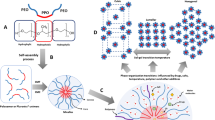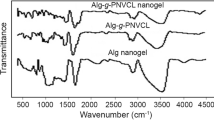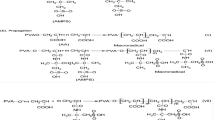ABSTRACT
Purpose
This work investigated the influence of a model protein, bovine serum albumin (BSA), on the properties of a thermogelling formulation intended for administration inside body compartments where there is high albumin content, as in the case of inflamed joints; it also explored the relation between the variation of these properties and release performance of methotrexate (MTX), a drug used to treat forms of arthritis and rheumatic conditions.
Methods
The influence of BSA on the micellisation and gelation behaviour of Poloxamer 407, chosen as a model copolymer, was studied by differential scanning calorimetry (microDSC), dynamic light scattering (DLS), fluorescence spectroscopy and rheology studies. A release study of MTX loaded inside the hydrogel in presence and in absence of BSA was performed.
Results
DLS and microDSC data revealed that the micellisation process was not affected by the protein, as demonstrated by unaltered micellar size and thermodynamic parameters. While the presence of BSA in the copolymer system reduced gel consistency, the hydrogel release performance was only slightly affected.
Conclusion
Our results suggested that the kinetics of MTX release mainly depended on the presence of the thermogelling copolymer, although other mechanisms related to BSA could be involved. Finally, the study assessed the feasibility of using a thermogelling hydrogel for in situ drug administration in areas with the presence of high protein concentrations.







Similar content being viewed by others
REFERENCES
Mizushima Y, Miyake H, Fujiwara K, Ono N, Takikawa K. A highly topically active corticosteroid. Preliminary report. Arzneim Forsch/Drug Res. 1980;30(2):274–5.
Hoshi K. Clinical application of DDS, steroid therapy and NSAIDs. Nippon Rinsho Jpn J Clin Med. 1989;47(6):1302–7.
Evans CH, Kraus VB, Setton LA. Progress in intra-articular therapy. Nat Rev Rheumatol. 2014;10(1):11–22.
Miao B, Song C, Ma G. Injectable thermosensitive hydrogels for intra-articular delivery of methotrexate. J Appl Polym Sci. 2011;122(3):2139–45.
Horisawa E, Hirota T, Kawazoe S, Yamada J, Yamamoto H, Takeuchi H, et al. Prolonged anti-inflammatory action of DL-lactide/glycolide copolymer nanospheres containing betamethasone sodium phosphate for an intra-articular delivery system in antigen-induced arthritic rabbit. Pharm Res. 2002;19(4):403–10.
Huang G, Zhang Z. Micro- and nano-carrier mediated intra-articular drug delivery systems for the treatment of osteoarthritis. J Nanotechnol. 2012.
Jeong B, Kim SW, Bae YH. Thermosensitive sol–gel reversible hydrogels. Adv Drug Deliv Rev. 2002;54(1):37–51.
Ruel-Gariépy E, Leroux J-C. In situ-forming hydrogels—review of temperature-sensitive systems. Eur J Pharm Biopharm. 2004;58(2):409–26.
Freeman ME, Furey MJ, Love BJ, Hampton JM. Friction, wear, and lubrication of hydrogels as synthetic articular cartilage. Wear. 2000;241(2):129–35.
Bonacucina G, Cespi M, Mencarelli G, Giorgioni G, Palmieri GF. Thermosensitive self-assembling block copolymers as drug delivery systems. Polymers. 2011;3(2):779–811.
Alexandridis P, Alan Hatton T. Poly(ethylene oxide)-poly(propylene oxide)-poly(ethylene oxide) block copolymer surfactants in aqueous solutions and at interfaces: thermodynamics, structure, dynamics, and modeling. Colloids Surf A Physicochem Eng Asp. 1995;96(1–2):1–46.
Perinelli DR, Cespi M, Pucciarelli S, Casettari L, Palmieri GF, Bonacucina G. Effect of phosphate buffer on the micellisation process of Poloxamer 407: microcalorimetry, acoustic spectroscopy and dynamic light scattering (DLS) studies. Colloids Surf A Physicochem Eng Asp. 2013;436:123–9.
Levick JR. Microvascular architecture and exchange in synovial joints. Microcirculation (New York, NY : 1994). 1995;2(3):217–33.
Wunder A, Müller-Ladner U, Stelzer EHK, Funk J, Neumann E, Stehle G, et al. Albumin-based drug delivery as novel therapeutic approach for rheumatoid arthritis. J Immunol. 2003;170(9):4793–801.
Kratz F. Albumin as a drug carrier: design of prodrugs, drug conjugates and nanoparticles. J Control Release. 2008;132(3):171–83.
Sterner B, Harms M, Weigandt M, Windbergs M, Lehr CM. Crystal suspensions of poorly soluble peptides for intra-articular application: a novel approach for biorelevant assessment of their in vitro release. Int J Pharm. 2014;461(1–2):46–53.
Li W, Wang H, Yang Y. Protein-modulated release behavior of a hydrophilic/lipophilic dual-drug from supramolecularly gelled microemulsions. RSC Adv. 2014;4(5):2109–14. doi:10.1039/C3RA45868G.
BASF. Poloxamer 407-Thickening agent and gel former for the pharmaceutical industry. 2005.
Lakowicz JR. Quenching of fluorescence. Principles of fluorescence spectroscopy. 3th ed: Springer; 2007.
Lewis GA, Mathieu D, Phan-Tau-Luu R, editors. Pharmaceutical experimental design. Marcel Dekker, Inc.
Liebenberg W, Engelbrecht E, Wessels A, Devarakonda B, Yang W, De Villiers MM. A comparative study of the release of active ingredients from semisolid cosmeceuticals measured with Franz, enhancer or flow-through cell diffusion apparatus. J Food Drug Anal. 2004;12(1):19–28.
Olejnik A, Goscianska J, Nowak I. Active compounds release from semisolid dosage forms. J Pharm Sci. 2012;101(11):4032–45.
Ueda CT, Shah VP, Derdzinski K, Ewing G, Flynn G, Maibach H, et al. Topical and transdermal drug products. Pharmacopeial Forum. 2009;35(3):750–64.
Bradford MM. A rapid and sensitive method for the quantitation of microgram quantities of protein utilizing the principle of protein-dye binding. Anal Biochem. 1976;72(1–2):248–54.
Bonacucina G, Spina M, Misici-Falzi M, Cespi M, Pucciarelli S, Angeletti M, et al. Effect of hydroxypropyl β-cyclodextrin on the self-assembling and thermogelation properties of Poloxamer 407. Eur J Pharm Sci. 2007;32(2):115–22.
Giancola C, De Sena C, Fessas D, Graziano G, Barone G. DSC studies on bovine serum albumin denaturation effects of ionic strength and SDS concentration. Int J Biol Macromol. 1997;20(3):193–204.
Zhang Y-Z, Zhou B, Liu Y-X, Zhou C-X, Ding X-L, Liu Y. Fluorescence study on the interaction of bovine serum albumin with P-aminoazobenzene. J Fluoresc. 2008;18(1):109–18.
Sułkowska A, Maciążek M, Równicka J, Bojko B, Pentak D, Sułkowski WW. Effect of temperature on the methotrexate – BSA interaction: spectroscopic study. J Mol Struct. 2007;834–836:162–9.
Chang EI, Galvez MG, Glotzbach JP, Hamou CD, El-ftesi S, Rappleye CT, et al. Vascular anastomosis using controlled phase transitions in poloxamer gels. Nat Med. 2011;17(9):1147–52. doi:10.1038/nm.2424.
Cespi M, Bonacucina G, Casettari L, Mencarelli G, Palmieri G. Poloxamer thermogel systems as medium for crystallization. Pharm Res. 2012;29(3):818–26.
Moore T, Croy S, Mallapragada S, Pandit N. Experimental investigation and mathematical modeling of Pluronic® F127 gel dissolution: drug release in stirred systems. J Control Release. 2000;67(2–3):191–202.
Anderson BC, Pandit NK, Mallapragada SK. Understanding drug release from poly(ethylene oxide)-b-poly(propylene oxide)-b-poly(ethylene oxide) gels. J Control Release. 2001;70(1–2):157–67.
Kim E-Y, Gao Z-G, Park J-S, Li H, Han K. rhEGF/HP-β-CD complex in poloxamer gel for ophthalmic delivery. Int J Pharm. 2002;233(1–2):159–67.
Katakam M, Ravis WR, Banga AK. Controlled release of human growth hormone in rats following parenteral administration of poloxamer gels. J Control Release. 1997;49(1):21–6.
Pucciarelli S, Bonacucina G, Bernabucci F, Cespi M, Mencarelli G, Fronzo G, et al. A study on the stability and enzymatic activity of yeast alcohol dehydrogenase in presence of the self-assembling block copolymer poloxamer 407. Appl Biochem Biotechnol. 2012;167(2):298–313.
Tayeh N, Rungassamy T, Albani JR. Fluorescence spectral resolution of tryptophan residues in bovine and human serum albumins. J Pharm Biomed Anal. 2009;50(2):107–16.
Author information
Authors and Affiliations
Corresponding author
Electronic supplementary material
Below is the link to the electronic supplementary material.
Table ST1
(DOC 34 kb)
Table ST2
(DOC 27 kb)
Table ST3
(DOC 29 kb)
Figure SF 1
Effect of the increasing concentration of P407 on the intrinsic fluorescence emission of BSA at 35°C. (JPEG 625 kb)
Figure SF 2
Effect of the increasing concentration of P407 on the intrinsic fluorescence emission of BSA at 10°C. (JPEG 662 kb)
Rights and permissions
About this article
Cite this article
Perinelli, D.R., Bonacucina, G., Pucciarelli, S. et al. Could Albumin Affect the Self-Assembling Properties of a Block Co-polymer System and Drug Release? An In-Vitro Study. Pharm Res 32, 1094–1104 (2015). https://doi.org/10.1007/s11095-014-1521-1
Received:
Accepted:
Published:
Issue Date:
DOI: https://doi.org/10.1007/s11095-014-1521-1




